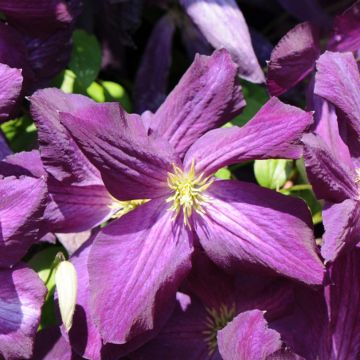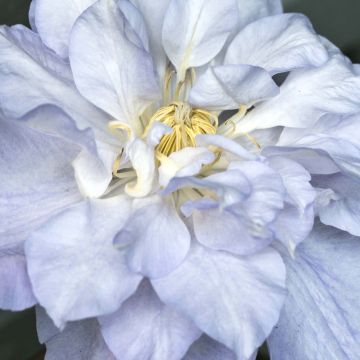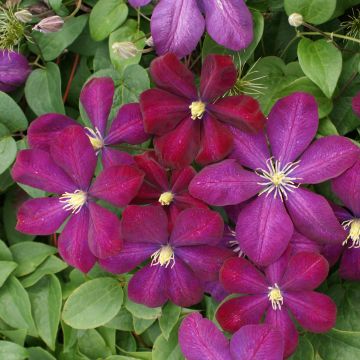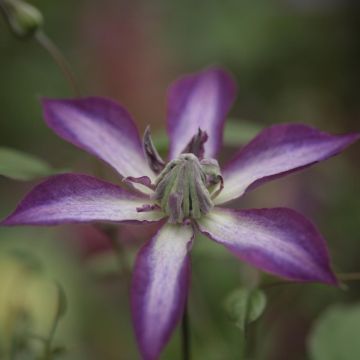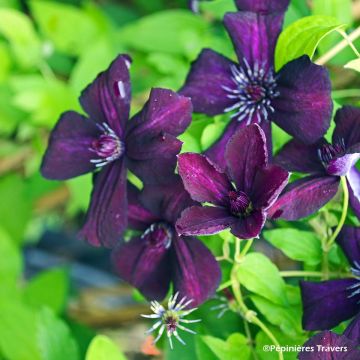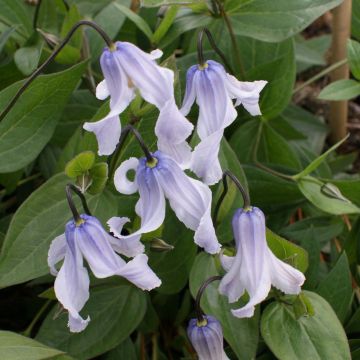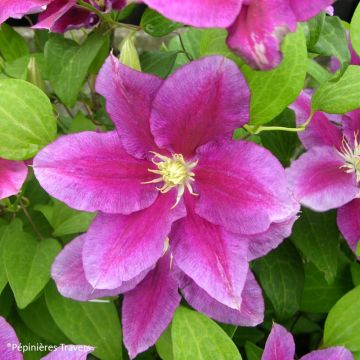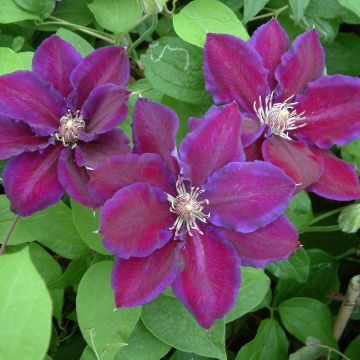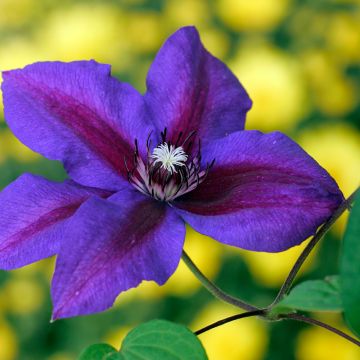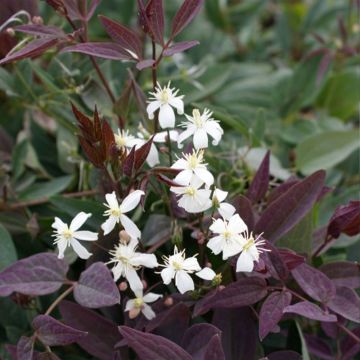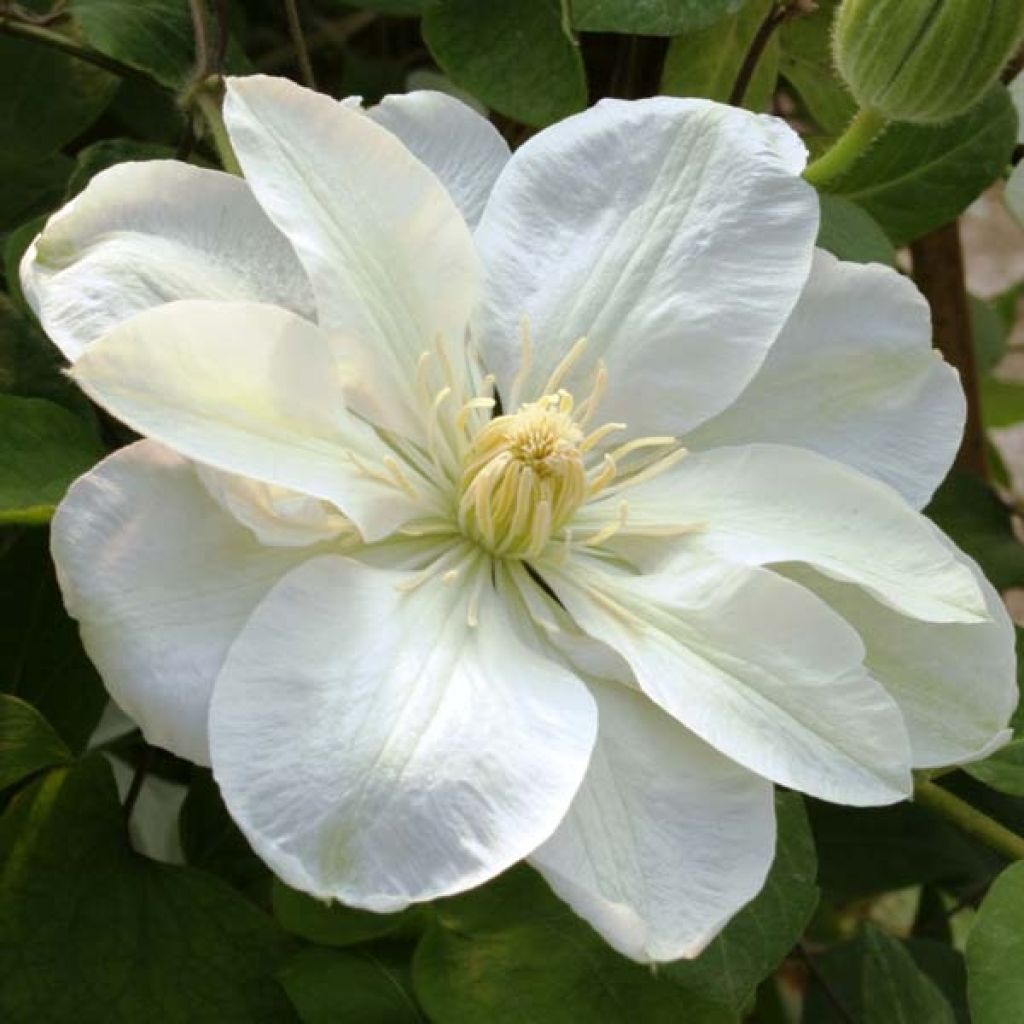

Clematis patens Guernsey Cream
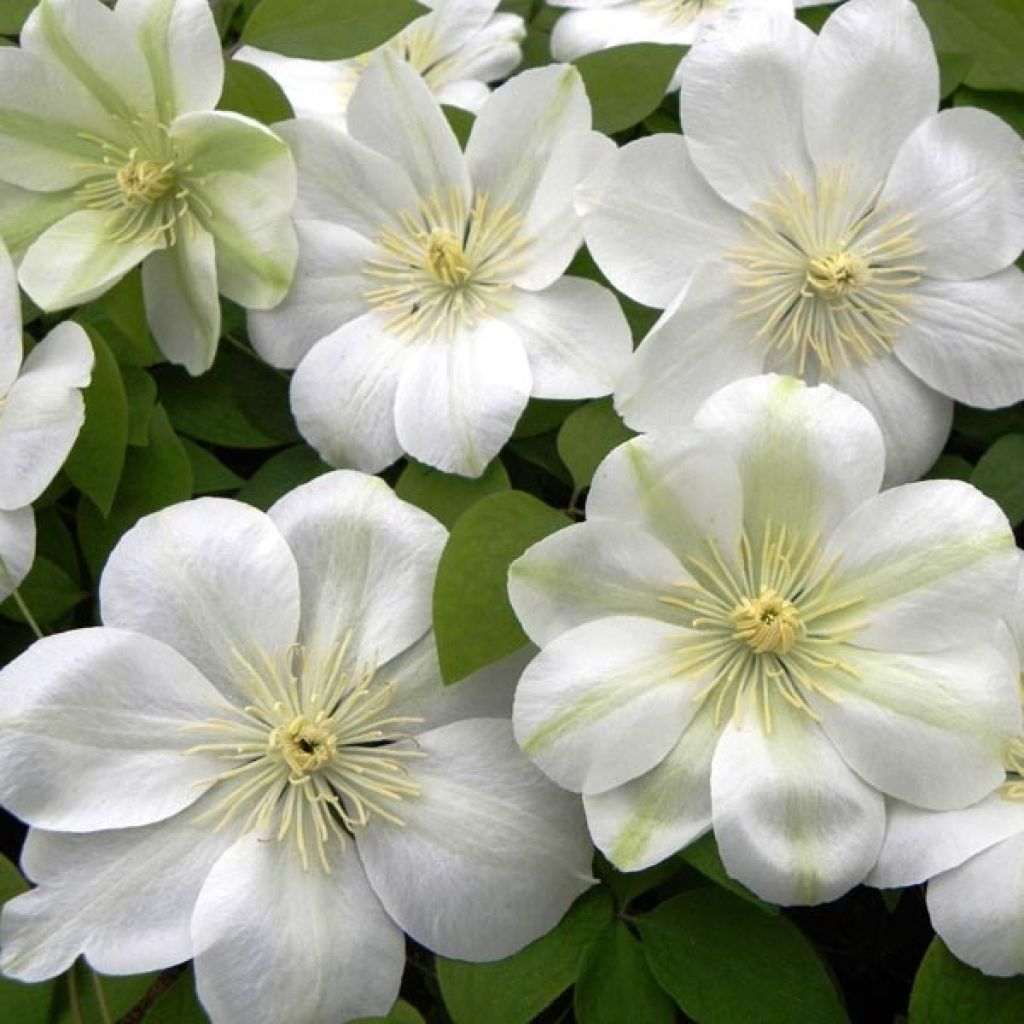

Clematis patens Guernsey Cream
Clematis patens Guernsey Cream
Clematis patens Guernsey Cream
Early large-flowered clematis, Clematis 'Guernsey Cream'
The plant arrived with 5 huge buds ready to open: flowering in a soft yellow/green tone somewhat reminiscent of polychrome euphorbias but lighter. Original colour and flower shape with thick, rounded petals as well.
MaDo51, 15/04/2024
This item cannot be shipped to the selected country
Delivery charge from €5.90
More information
Schedule delivery date,
and select date in basket
This plant carries a 6 months recovery warranty
More information
We guarantee the quality of our plants for a full growing cycle, and will replace at our expense any plant that fails to recover under normal climatic and planting conditions.
From €5.90 for pickup delivery and €6.90 for home delivery
Express home delivery from €8.90.

Does this plant fit my garden?
Set up your Plantfit profile →
Description
Clematis 'Guernsey Cream' is an early, reliable, and vigorous variety that blooms generously in spring and again at the end of summer. Its large, round flowers are a very pale-yellow delicately shaded with green, fading to creamy-white with prominent yellow stamens in the centre. In September, they will be smaller and off-white. The intense freshness of its flowering works wonders alongside pastel roses, in a bush with purple foliage. This clematis can climb anywhere, clinging to arbours, trellises, fences, and pergolas. Its moderate size is ideal for small gardens.
Clematis belongs to the Ranunculaceae family. The 'Guernsey Cream' variety has received the RHS Award of Garden Merit for its ornamental qualities and performance in the garden. It was bred in England by Raymond Evison. This variety possesses the genes of Clematis patens, a beautiful Japanese species with large flowers of varying colours, which is the origin of many cultivars.
This semi-woody and climbing plant is perfectly perennial and hardy. It will reach a height of about 4m (13ft), with a minimum spread of 1.25m (4ft). 'Guernsey Cream' develops new shoots in spring, from buds located on older stems. Each stem produces a floral bud that blooms in May-June. A second flowering occurs on the young stems in August-September. At the beginning of the season, this variety bears very round flowers with eight wide tepals, 12 to 15cm (5 to 6in) in diameter. They are pale-yellow with a chartreuse green midrib at first, then become creamy-white when fully open. They are erect and have a beautiful bouquet of yellow stamens in the centre. The flowering is followed by decorative silver-grey feathery fruits that persist until winter. The dark green deciduous leaves are divided into 3 or more leaflets. This clematis clings on its own to the support or host plant using petioles transformed into tendrils.
Plant your clematis alongside climbing roses to extend the flowering period of walls and pergolas until the end of summer. Place pretty perennials like geraniums, carnations, sage nemorosa, and phlox at their base, which will provide the shade they appreciate. This is a diverse genus, with varieties available in all colours, shapes, and sizes. Take advantage of their easy cultivation to give your garden a romantic and bohemian touch. 'Guernsey Cream' loves to weave through bushes. Bamboo canes are perfect supports for its voluble stems. The decidedly pastel flowers of this variety will be beautiful in September, alongside those of pink, orange, or red roses, for example. It will work wonders on an obelisk, in the centre of a perennial bed, or even on a wire fence.
Report an error about the product description
Clematis patens Guernsey Cream in pictures
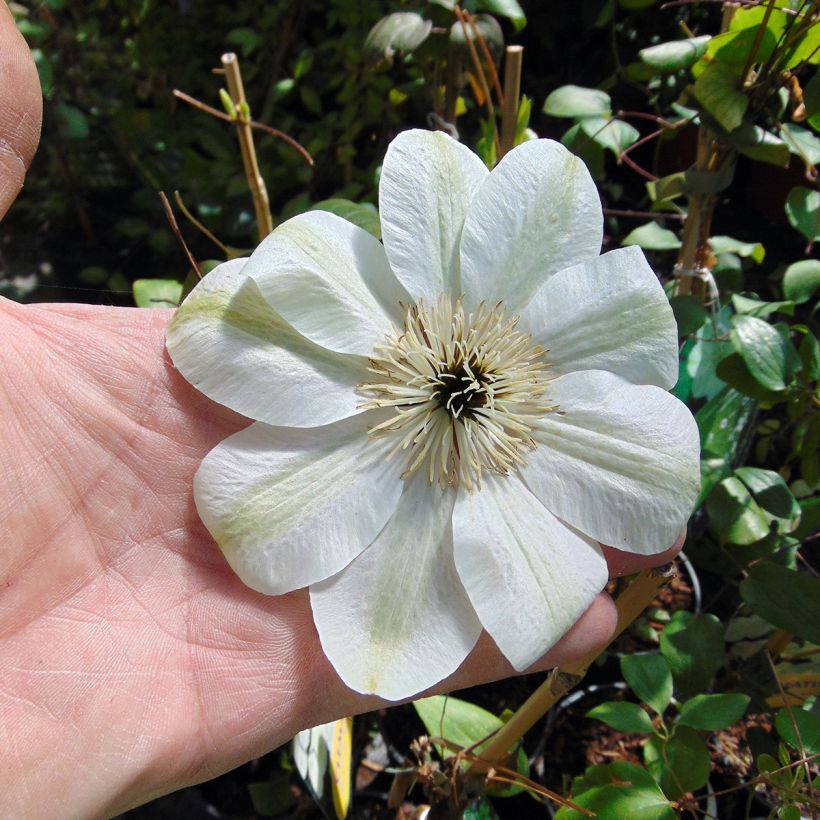

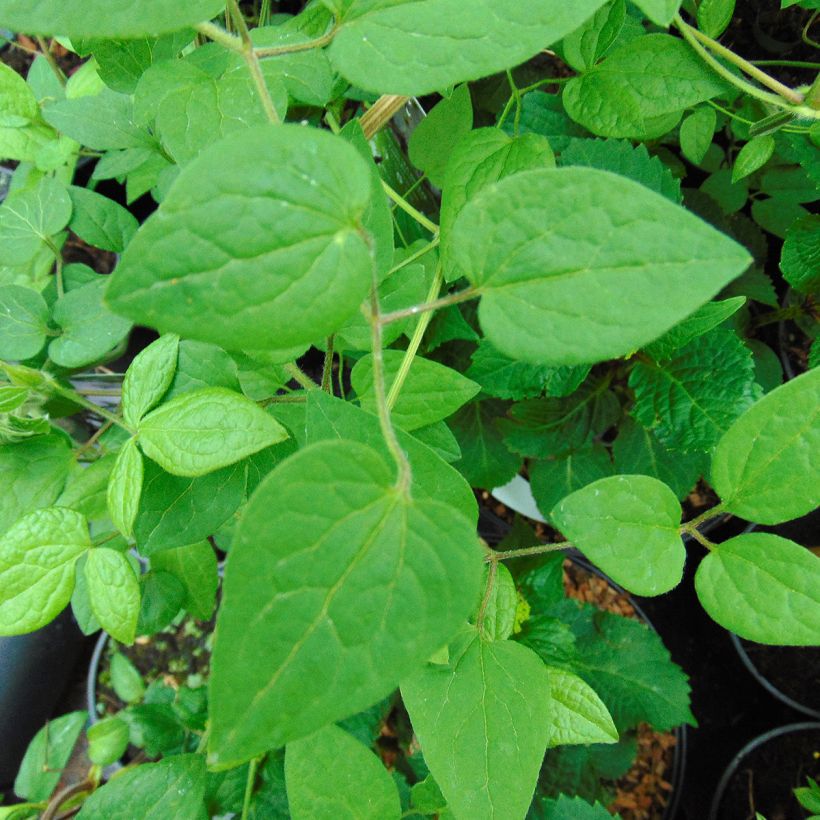

Plant habit
Flowering
Foliage
Botanical data
Clematis
patens
Guernsey Cream
Ranunculaceae
Early large-flowered clematis, Clematis 'Guernsey Cream'
Cultivar or hybrid
Other Clematis A to Z
Planting and care
Place Clematis 'Guernsey Cream' in a shady spot. Maintain moisture by using a mulch made of garden compost or well-rotted manure in February, avoiding contact with the stem. This will limit the risk of wilting and allow new vigorous shoots to emerge from the stump. You can also keep the base cool with a ground cover plant or a perennial geranium. Place the head of the clematis in the sun. Work the soil well and enrich it with good quality potting soil. Place the clematis, covering the root ball with 3cm (1in) of soil. It is important to water regularly but in small amounts. Avoid watering directly onto the base. Do not let water stagnate as this can lead to the development of a fungus at the collar.
Prune dead or weak stems in early March before the start of growth, and cut back the others to about 30cm (12in) above ground level. This will help densify the plant and increase its flowering. Remove faded flowers for a longer blooming period.
Clematis cling on their own thanks to their tendrils. To promote their growth, provide them with a trellis support or let them dress the trunk of a tree by placing a wire mesh against the trunk for the clematis to climb on. Clematis also like to grow freely on neighbouring plants.
Planting period
Intended location
Care
-
, onOrder confirmed
Reply from on Promesse de fleurs
Clematis
Haven't found what you were looking for?
Hardiness is the lowest winter temperature a plant can endure without suffering serious damage or even dying. However, hardiness is affected by location (a sheltered area, such as a patio), protection (winter cover) and soil type (hardiness is improved by well-drained soil).

Photo Sharing Terms & Conditions
In order to encourage gardeners to interact and share their experiences, Promesse de fleurs offers various media enabling content to be uploaded onto its Site - in particular via the ‘Photo sharing’ module.
The User agrees to refrain from:
- Posting any content that is illegal, prejudicial, insulting, racist, inciteful to hatred, revisionist, contrary to public decency, that infringes on privacy or on the privacy rights of third parties, in particular the publicity rights of persons and goods, intellectual property rights, or the right to privacy.
- Submitting content on behalf of a third party;
- Impersonate the identity of a third party and/or publish any personal information about a third party;
In general, the User undertakes to refrain from any unethical behaviour.
All Content (in particular text, comments, files, images, photos, videos, creative works, etc.), which may be subject to property or intellectual property rights, image or other private rights, shall remain the property of the User, subject to the limited rights granted by the terms of the licence granted by Promesse de fleurs as stated below. Users are at liberty to publish or not to publish such Content on the Site, notably via the ‘Photo Sharing’ facility, and accept that this Content shall be made public and freely accessible, notably on the Internet.
Users further acknowledge, undertake to have ,and guarantee that they hold all necessary rights and permissions to publish such material on the Site, in particular with regard to the legislation in force pertaining to any privacy, property, intellectual property, image, or contractual rights, or rights of any other nature. By publishing such Content on the Site, Users acknowledge accepting full liability as publishers of the Content within the meaning of the law, and grant Promesse de fleurs, free of charge, an inclusive, worldwide licence for the said Content for the entire duration of its publication, including all reproduction, representation, up/downloading, displaying, performing, transmission, and storage rights.
Users also grant permission for their name to be linked to the Content and accept that this link may not always be made available.
By engaging in posting material, Users consent to their Content becoming automatically accessible on the Internet, in particular on other sites and/or blogs and/or web pages of the Promesse de fleurs site, including in particular social pages and the Promesse de fleurs catalogue.
Users may secure the removal of entrusted content free of charge by issuing a simple request via our contact form.
The flowering period indicated on our website applies to countries and regions located in USDA zone 8 (France, the United Kingdom, Ireland, the Netherlands, etc.)
It will vary according to where you live:
- In zones 9 to 10 (Italy, Spain, Greece, etc.), flowering will occur about 2 to 4 weeks earlier.
- In zones 6 to 7 (Germany, Poland, Slovenia, and lower mountainous regions), flowering will be delayed by 2 to 3 weeks.
- In zone 5 (Central Europe, Scandinavia), blooming will be delayed by 3 to 5 weeks.
In temperate climates, pruning of spring-flowering shrubs (forsythia, spireas, etc.) should be done just after flowering.
Pruning of summer-flowering shrubs (Indian Lilac, Perovskia, etc.) can be done in winter or spring.
In cold regions as well as with frost-sensitive plants, avoid pruning too early when severe frosts may still occur.
The planting period indicated on our website applies to countries and regions located in USDA zone 8 (France, United Kingdom, Ireland, Netherlands).
It will vary according to where you live:
- In Mediterranean zones (Marseille, Madrid, Milan, etc.), autumn and winter are the best planting periods.
- In continental zones (Strasbourg, Munich, Vienna, etc.), delay planting by 2 to 3 weeks in spring and bring it forward by 2 to 4 weeks in autumn.
- In mountainous regions (the Alps, Pyrenees, Carpathians, etc.), it is best to plant in late spring (May-June) or late summer (August-September).
The harvesting period indicated on our website applies to countries and regions in USDA zone 8 (France, England, Ireland, the Netherlands).
In colder areas (Scandinavia, Poland, Austria...) fruit and vegetable harvests are likely to be delayed by 3-4 weeks.
In warmer areas (Italy, Spain, Greece, etc.), harvesting will probably take place earlier, depending on weather conditions.
The sowing periods indicated on our website apply to countries and regions within USDA Zone 8 (France, UK, Ireland, Netherlands).
In colder areas (Scandinavia, Poland, Austria...), delay any outdoor sowing by 3-4 weeks, or sow under glass.
In warmer climes (Italy, Spain, Greece, etc.), bring outdoor sowing forward by a few weeks.

































